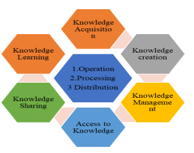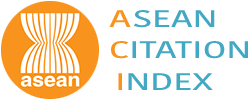Integrating Wisdom Management Models in Community Weaving Groups of Luang Prabang Province, Lao PDR
DOI:
https://doi.org/10.57260/csdj.2025.274345Keywords:
Weaving wisdom, Knowledge management model, Lao PDRAbstract
This qualitative research aims to study the knowledge management practices and the mode of weaving knowledge management among weaving group members in Luang Prabang province, Lao PDR. The study's sample for weaving knowledge management includes 326 members from weaving groups across 15 villages. Additionally, the sample group for examining the knowledge management model comprises 20 individuals, including leaders of the weaving groups and cultural officials at the district and provincial levels. Data collection was conducted through in-depth interviews with the sample and group discussions using predefined discussion points.
The results indicate that weaving has become the primary occupation and a significant income source for families and communities by integrating traditional wisdom with new knowledge acquired from weaving operations, development, and distribution. Although the members of the weaving group in Luang Prabang province have not yet formalized the documentation of weaving knowledge and wisdom, they exhibit an effective weaving process through various stages. These stages include knowledge searching, creation, systematic processing, filtering, accessing, and sharing among members. The researchers identified these seven steps as crucial in the knowledge management practices of the weaving group members in Luang Prabang, Lao People's Democratic Republic.
The model of weaving knowledge management reveals that the government sector plays a crucial role in supporting these practices by formulating policies that promote weaving, providing expert support, and allocating budgets to establish scholars and learning corners within the community, as well as for marketing initiatives. Additionally, the business sector is instrumental in funding equipment, training, and promoting weaving activities. The membership, comprising weaving group members and their leaders, is fundamental to the weaving production line. These individuals are pivotal in driving change and achieving community goals. Creating learning spaces and exchange opportunities for local people to trade their products at fair prices can help preserve local weaving sustainability.
Downloads
References
Butstee, N., Sawasdee, A., Weeraphalangkoo, W., & Chueakham, N. (2020). Local Wisdom Transmission on Weaving of Lungpradu Community, Tambon Lungpradu, Huai Thalaeng district, Nakhon Rajchasema province . Journal of Humanities and Social science, 1, 56-67. Retrieved from https://so06.tci-thaijo.org/index.php/husojournalpnru/article/view/245633
Chaowakul, P. (1997). Factors Influencing the Business Operations of the Nong Bua Noi Agricultural Housewives Group in Nong Thap Thai Subdistrict, Phanom Phrai District, Roi Et Province. Mahasarakharm: Mahasarakharm University.
Dethkulthong, P., Chaipakdee, D., & Sintorn, S. (2022). Consumer satisfaction with products based on the creative economy concept of the silk weaving profession of women at Ban Siao Noi, Mueang District, Chaiyaphum Province. UDON THANI RAJABHAT UNIVERSITY ACADEMIC JOURNAL, 10(1), 67-81. Retrieved from https://so06.tci-thaijo.org/index.php/UDRUAJ/article/view/255859
Department of Industry and Handicraft. (2019). A promotion Traditional Weaving Product. Vientiane: Ministry of Industry and Commerce .
Ministry of Planning and Investment . (2017). National social economic development plan. Vientiane: Ministry of Planning and Investment .
Na-Klang, E. (2003). Local wisdom and Knowledge management . Bangkok : Amarin printing and Publishing.
Pooripakdee, S. (2018). The development of knowledge for product value creation to enhance competitiveness for OTOP enterpreneures in Phetchaburi, Prachuab Khririkhan, Samut Songkhram and Samut Sakhon. Veridian E-Journal, 11(2), 2153-2168 . Retrieved from https://he02.tci-thaijo.org/index.php/Veridian-E-Journal/article/view/144171
Phattaradulpitak, S. (2005). The management of local wisdom knowledge of cotton dyed with tree bark from Ban Non Suksa, Na Udom Subdistrict, Phon Thong District, Roi Et Province. Udonthany: Udonthany Rajphat University.
Somakasetrin, J. (2008). Local Wisdom Management in Si Sa Ket Province for Competitive Advantage. Bangkok : National research council of Thailand.
Thanasanti, S., & Saisena, M. (2017). The development of a model for managing local wisdom knowledge in tie-dye fabric. Silapasat Ubon Ratchathani University, 13(2), 217-238. Retrieved from https://so03.tci-thaijo.org/index.php/jla_ubu/article/view/242578
Thangpitakkri, A., & Jamsai, T. (2020). Approach Towards Value Increment and Online Marketing of Sweet Corn Products in Sirattana District, Sisaket Province. Local Governnace and Innovation, 4(3), 99-112. Retrieved from https://so03.tci-thaijo.org/index.php/JLGISRRU/article/view/246110
Thotsata, O., Jaiotton, S., & Pilabut, S.. (2020). The transmission of indigenous wisdom in silk weaving, Pak Thong Chai District, Nakhon Ratchasima Province. Academic Journal of Northern, 7(1), 88-89. Retrieved from https://so09.tci-thaijo.org/index.php/AJntc/article/view/1379
Vanitbancha, K. (2005). Statistics for Research. Bangkok: Chulalongkorn University.

Downloads
Published
How to Cite
Issue
Section
Categories
License
Copyright (c) 2025 Community and Social Development Journal

This work is licensed under a Creative Commons Attribution-NonCommercial-NoDerivatives 4.0 International License.
1. Articles, information, content, images, etc published in the “Community and Social Development Journal” are copyrighted by the Community and Social Development Journal, Chiang Mai Rajabhat University. In order to properly distribute the articles through print and electronic media, the authors still hold the copyright for the published articles under the Creative Commons Attribution (CC BY) license, which allows the re-distribution of the articles in other sources. References must be made to the articles in the journal. The authors are responsible for requesting permission to reproduce copyrighted content from other sources.
2. The content of the articles appearing in the journal is the direct responsibility of the article authors. The editorial board of the journal does not necessarily agree with or share any responsibility.













